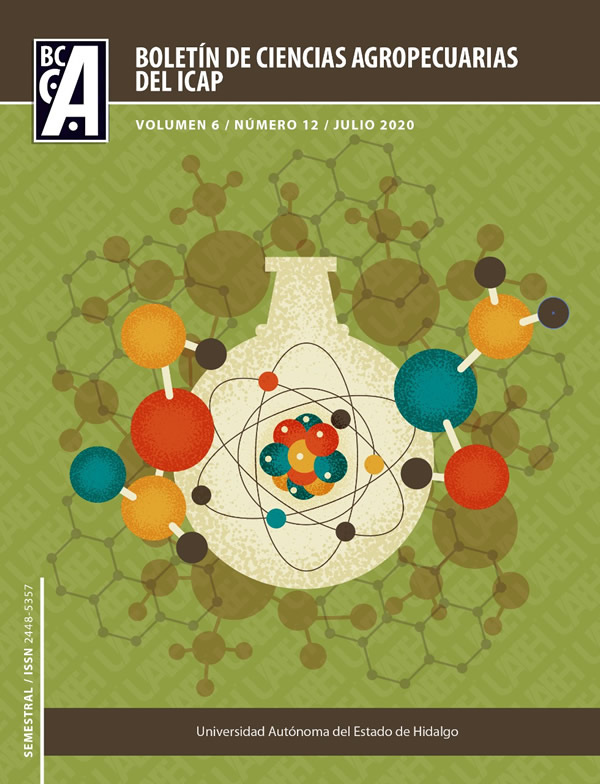Production and uses of Tenebrio molitor
Abstract
The aim of work is to propose the insect Tenebrio molitor as a nutritional alternative and report on their production methods, because not only have nutritional characteristics needed for a good diet for its nutritional high, but also have a variety of qualities beneficial to the health of consumers. It is well known that Mexico is a country with nutritional problems, due to lack of knowledge about nutritional deficiencies and options that people have in their diet; so that an alternative to this problem is to expand knowledge and food choices. Tenebrio molitor is known as a nutritional option for the large number of proteins containing, which provide a nutritional option, in addition to the health benefits that may be due to the presence of bioactive peptides. Not much is known about the management that these insects must have to avoid pests or infections during their production, in addition to the specific care necessary for rapid and sustainable production.
Downloads
References
Allende M. Como criar Tenebrios (gusano de la harina) para alimento de gallina. Revista vía orgánica 2015; 3-6.
Arana, E. (2018). Manejo en cautiverio de tenebrio molitor usando cinco tipos de harina. División de ciencias e ingenieria, 4-29.
Barnes AI, Silva-Jothy MT. Density–dependent prophylaxis in the mealworm beetle Tenebrio molitor L. (Coleoptera: Tenebrionidae): cuticular melanization is an indicator of investment in immunity. Proc Biol Sci 2000; 267(1439): 177–182. DOI: 10.1098/rspb.2000.0984
Barrientos JA. Curso práctico de entomología. Universidad Autónoma de Barcelona. Servei publicacions. España. 2004; 947 pág. ISBN 84-490-2383-1.
Bovera F, Loponte R, Marono S, Piccolo G, Parisi G, Laconisi V, Gasco L, Nizza A. Use of Tenebrio molitor larvae meal as protein source in broiler diet: Effect on growth performance, nutrient digestibility, and carcass and meat traits J Anim Sci 2016; 94(2): 639–647. https://doi.org/10.2527/jas.2015-9201
Bukkens SGF. The nutritional value of edible insects, Ecol Food Nut 1997; 36(2-4): 287-319. DOI: 10.1080/03670244.1997.9991521
Coronado PR, Márquez AD. Introducción a la entomología, morfología y taxonomía de los insectos. Agencia para el Desarrollo Internacional. Centro Regional de Ayuda Técnica. México, DF 1972; 282 pág.
Feng S. Tenebrio molitor L., entomophagy and processing into ready to use therapeutic ingredients: a review. J Nutr Health Food Eng 2018; 8(3): 280‒285. DOI: 10.15406/jnhfe.2018.08.00283
Fraenkel G. The nutrition of the mealworm, Tenebrio molitor L. (Tenebrionidae, Coleoptera). Physiological Zoology 1950; 23(2): 92-108.
Gasco L, Belforti M, Rotolo L, Lussiana C, Parisi G, Terova G, Roncarati A, Gai F. Mealworm (Tenebrio molitor) as a potential ingredient in practical diets for rainbow trout (Oncorhynchus mykiss). Abstract book Conference “Insects to Feed The World” 2015; 14-17.
Van Huis A. Edible insects contributing to food security? Agric & Food Secur 2015; 4:20. DOI 10.1186/s40066-015-0041-5
Intriago TSC, Valencia YB. Determinación de antocianinas y valor nutricional de los tenebrios (Tenebrio molitor) alimentados con dietas enriquecidas con maíz morado (Zea Mays L.). Universidad Politécnica Salesiana, Ecuador. Tesis de Licenciatura. 2014. 77pág.
Iaconisi, V., Marono, S., Parisi, G., Gasco, L., Genovese, L., Maricchiolo, G., & Piccolo, G. (2017). Dietary inclusion of Tenebrio molitor larvae meal: Effects on growth performance and final quality treats of blackspot sea bream (Pagellus bogaraveo). Aquaculture, 476, 49-58. https://doi.org/10.1016/j.aquaculture.2017.04.007
Leyuan , L., Beiz hen , X., Dong , C., Wang , M., & Hong Liu. (2016). Can closed artificial ecosystem have an impact on insect microbial community? A case study of yellow mealworm (Tenebrio molitor L.). Ecological engineering, 183-189
Loudon, C. (1988). Desarrollo de Tenebrio molitor en bajos niveles de oxígeno. Fisiología de insectos, 97-103.
Menhinick, E., & Crossley , D. (1968). Una comparación de los perfiles de radiación de Acheta domesticus y Tenebrio molitor. Reino Unido: Annals of the entomological society of america.
Moreno DMG. Efecto de una bebida a base de Tenebrio molitor sobre la hepatocarcinogénesis experimental en el ratón. Universidad Autónoma del Estado de Hidalgo, México. Tesis de Maestría. 2018.
Moret Y, Siva-Jothy MT. Adaptive innate immunity? Responsive-mode prophylaxis in the mealworm beetle, Tenebrio molitor. Proc Biol Sci 2003; 270(1532): 2475–2480. DOI: 10.1098/rspb.2003.2511.
Damborsky MP, Sandrigo-Ybran T, Bar ME, Oscherov E. Ciclo de Vida de Tenebrio molitor (Coleoptera, Tenebrionidae) en Condiciones Experimentales. UNNE 1999; 6: 52-68.
Iaconisi, V., Secci, G., Sabatino, G., Piccolo, G., Gasco, L., Papini, A. M., & Parisi, G. (2019). Effect of mealworm (Tenebrio molitor L.) larvae meal on amino acid composition of gilthead sea bream (Sparus aurata L.) and rainbow trout (Oncorhynchus mykiss W.) fillets. Aquaculture, 513, 734403. https://doi.org/10.1016/j.aquaculture.2019.734403
Mendoza Calvo C. (2020). Insectos a la carta. Revisado 08/04/2020. Disponible en: https://insectosalacarta.com/insectos-comestibles
Rantala MJ, Kortet R, Kotiaho JS, Vainikka A, Suhonen J. Condition dependence of pheromones and immune function in the grain beetle Tenebrio molitor. Functional Ecology 2003; 17: 534-540. https://doi.org/10.1046/j.1365-2435.2003.00764.x
Romer, F., Emmerich, H., & Nowock, J. (1974). Biosynthesis of ecdysones in isolated prothoracic glands and oenocytes of Tenebrio molitor in vitro. Journal of insect physiology, 20(10), 1975-1987. https://doi.org/10.1016/0022-1910(74)90105-X
Roncarati A, Gasco L, Parisi G, & Terova G. Growth performance of common catfish (Ameiurus melas Raf.) fingerlings fed mealworm (Tenebrio molitor) diet. J Insect Food Feed 2015; 1(3): 233-240. https://doi.org/10.3920/JIFF2014.0006
Soares de Castro RJ, Ohara A, Goncalves dos Santos JA, Fontenele MAD. Nutritional, functional and biological properties of insect proteins: Processes for obtaining, consumption and future challenges. Trends Food Sci Tech 2018; 76: 82-89. https://doi.org/10.1016/j.tifs.2018.04.006
Weaver, D., & McFarlane, J. (1990). El efecto de la densidad larval en el crecimiento y desarrollo de Tenebrio molitor. Fisiología de insectos, 531-536.
Zamora, J., Martínez, N., Guerrero, M., Fuentes-Guerra, J., & Hernández, C. (2009). Control hormonal de la metamorfosis: hormona de la muda (o ecdisona), hormona juvenil. Open course ware Universidad de Sevilla, 7-8.










